by bria4123 on February 6, 2012
Cologne’s medieval heritage is one of the West’s most splendid and influential, but most Western Civ classes and books leave it out. Its Romanesque and Gothic buildings were some of the highlights of a 4 month trip I took through Northern Europe in 2010.
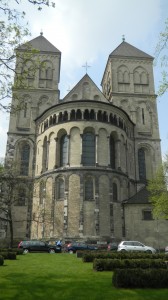
The stately Romanesque jewel above is St. Kunibert’s church. It’s the northernmost Romanesque church in Cologne. It’s on the Rhine, and the facade you see above faces the river. So people who sailed into this busy commercial hub immediately saw these ordered forms. They stated that Cologne is a city of law-abiding Christian merchants. This facade also hinted at other gems in one of Northern Europe’s most spectacular medieval cities. [click to continue…]
by bria4123 on February 5, 2012
Gothic style lives!
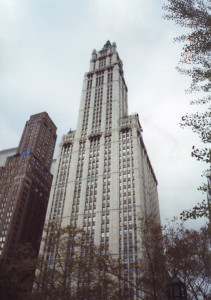
The Woolworth Tower was completed in Lower Manhattan in 1913. As the tallest building in the world with floors from bottom to top until the Chrysler Building eclipsed it in 1930, it reigned in full Gothic glory.
It still does–New Yorkers still consider it one of their favorite skyscrapers. The Shanghai World Financial Center was designed after yin-yang flows of energy. The Woolworth Tower used the West’s hallowed lines and arches. Cultures often use their most traditional art forms when they build their tallest buildings. A few more examples show that you can often see the ancient world in the modern. [click to continue…]
by bria4123 on February 4, 2012
Let’s take a quick flight to China. You can see ancient Chinese and modern global currents in China’s current tallest building, the Shanghai World Financial Center.
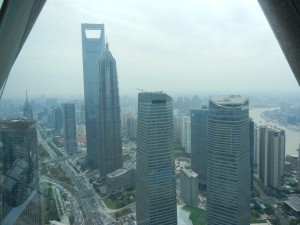
It soars up to 1614 feet in the picture above, and looms behind the Jin Mao tower (1380 ft). You can take its nosebleed elevator to the observation room over the empty space that you can see above the Jin Mao tower. Come along for a view of the modern city and the ancient past. [click to continue…]
by bria4123 on February 3, 2012
The Celtic and Germanic traditions are often left out of Western Civ studies. But they comprise its third leg, along with the Greco-Roman and Judeo-Christian traditions. We’ll peek at the Celtic world here the Celtic way, with a merry heart. Glass of stout optional.
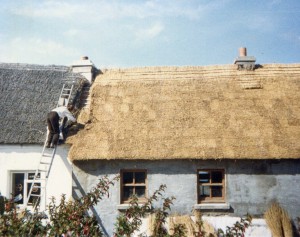
My friend John Seto, from the California Council For The Humanities, noted the precarious angle of the ladder in the above photo I took on the Aran Islands. It’s Irish logic: passion over practicality. Follow your impulse first, and think later. Am I joking? It’s followed in politics too. Come inside for a story, but don’t trip on the way. [click to continue…]
by bria4123 on February 2, 2012
Cologne’s Gothic cathedral always gets top billing. Not fair. Cologne’s other medieval churches add up to even more splendor.
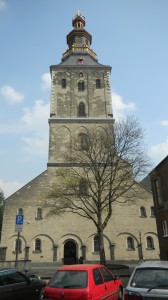
Cologne was the largest German city in the Middle Ages. An enormous wall surrounded it, and 12 great Romanesque churches were built. People riding or walking towards Cologne saw the spires glittering over the walls and imagined they were approaching the earthly counterpart of the City of God–the New Jerusalem. Come through the gate. [click to continue…]
by bria4123 on February 2, 2012
The last post flew between many cultures at 6,000MPH, so we’ll balance it today with a view of the same Khmer temple from Planet Earth.
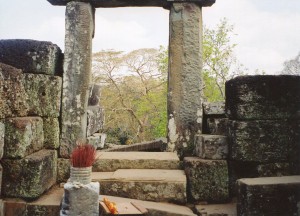
Yes, Phimeanakas was the royal chapel in the middle of the palace in Angkor, and the 11th century king Suryavarman I used its symmetry to order the state. But a colorful folk tale about it emerged. [click to continue…]
by bria4123 on February 1, 2012
Similar things were happening in Angkor and Medieval Europe in the 11th century. Both lands were becoming more politically centralized under strong rulers who built symmetrical monuments. These buildings expressed the all-encompassing order that kings and religious authorities wanted to impose.
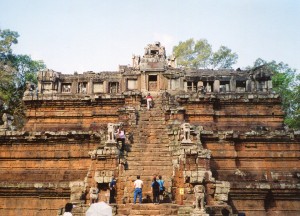
But the symmetries that 11th century Angkor and Europe preferred are very different. The forms that each society used to unify itself have deep cultural roots, and they’ll take you into two fascinating worlds. [click to continue…]
by bria4123 on February 1, 2012
The city of Worms by the upper Rhine River is a hallowed place in German history. Key events in German epics from pagan times took place there. So it was choice real estate for another great Romanesque cathedral. The building gave me a revelation.
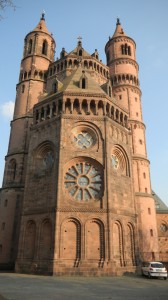
I explored its interior until closing time. Then I walked around the east end, outside of the apse, where I took the above photo. The bells in the towers began to clang. They created one of the most powerful sounds I’ve ever heard, and I’m a seasoned hard rock lead guitarist. [click to continue…]
by bria4123 on January 31, 2012
As Medieval Europe’s towns grew in the 11th and 12th centuries, Jewish intellectual life lit up.
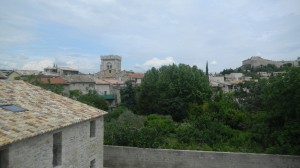
But the Romanesque and Gothic cathedrals that were built portrayed all-encompassing views of the universe only in Christian terms. As glorious as these cathedrals are, they were blind to their neighbors, who lived in the same towns, within sight of their towers. [click to continue…]
by bria4123 on January 31, 2012
Something was missing. Those stately Romanesque and Gothic arches in the cathedrals I spent 4 months exploring in 2010 were supposed to encompass everything God created, but they left out some of the people who helped build their society.
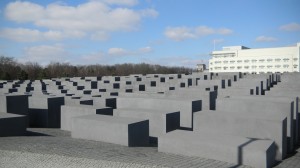
Cities that built some of the greatest cathedrals, including Speyer, Mainz, Worms, Rouen, Troyes, Cologne, Bonn and Strasbourg, had thriving Jewish communities with some of Europe’s most vibrant intellectual life. But you have to dig to find them. [click to continue…]










